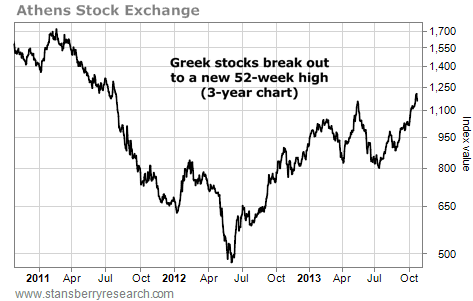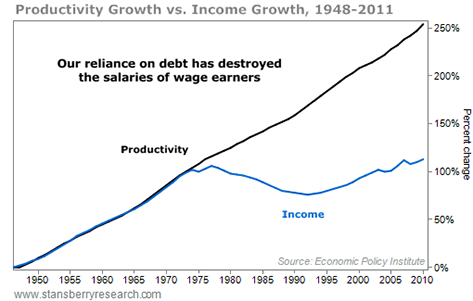| Home | About Us | Resources | Archive | Free Reports | Market Window |
The Story of How America Was Packaged and SoldBy
Friday, October 25, 2013
A building – One Chase Plaza – was sold last Thursday in New York for $750 million.
Not surprisingly, the building was bought by a Chinese asset-management firm, Fosun.
Today's essay is about this deal... and the massive economic forces that lie behind it. The story of One Chase Plaza is the story of how America was sold to its bankers. It's the story of how inflation plundered our wages. It's the story of how credit, rather than savings, came to dominate our economy and transform our way of life.
It's the story of how America was packaged and sold to our foreign creditors – mostly the Chinese...
Since 1996, the Chinese have made 51 major acquisitions in America, including deals to own or control iconic U.S. assets like computer giant IBM, carmaker GM, meat producer Smithfield Foods, U.S. power company AES Corp., major airplane lessor International Lease Finance Corp., investment bank Morgan Stanley, and private-equity firm Blackstone Group. They've also bought trophy real estate around the U.S., like the GM Tower.
These deals didn't happen by accident. They happened because the U.S. continues to consume far more than it produces. We finance this consumption with debt that's owned in large measure by foreign creditors. Take the U.S. Treasury debt, for example. At nearly $17 trillion, this is the world's largest pile of obligations. If you exclude Treasury obligations held by the U.S. government and the Federal Reserve, 54% of the remaining obligations are held by foreign creditors. And these foreign debts continue to grow rapidly – at about $500 billion annually.
Debt service on these obligations allows our foreign creditors to continually buy America's best assets. Today, foreign creditors directly own and control U.S. assets worth more than $25 trillion. That's roughly a third of all the wealth in America. And that's far more than what Americans own overseas: Americans only own about $20 trillion of foreign assets.
Every year that goes by, our foreign rivals will earn more on their American assets than we're able to earn on our foreign investments. They will grow wealthier and wealthier... while we become poorer and poorer in comparison.
As Warren Buffett famously said about this situation 10 years ago: "We have entered the world of negative compounding – goodbye pleasure, hello pain."
How did this happen? Why is it continuing? And why is it almost certain to lead to an enormous currency crisis? The story starts with One Chase Plaza...
In 1957, America was the most powerful country in the world. We controlled roughly 75% of all of the world's economic activity, and we owned the three most important corporations in the world: General Motors, Exxon (Standard Oil), and Chase Bank (the Rockefeller Bank). Our country's products – like the '57 Chevy – were the finest available in the world. We dominated every foreign competitor in manufacturing, energy, banking, and just about every other industry, too.
At the time, you might recall, our dollar was literally as good as gold: By international agreement, our foreign creditors could exchange their dollars for gold for $35 per ounce at the Federal Reserve Bank of New York. This firm limit on the value of the dollar protected the middle class in America, guaranteeing that every wage-earner in the economy would share in gains from increased productivity. As productivity increased, the dollar bought more goods and services. As a result, real after-tax income increased. What was good for GM actually was good for America, too.
The firm value of the U.S. dollar also protected America from the temptation of credit. By linking the dollar to gold, expansion of credit required an increase in gold reserves. Under these rules, the supply of additional gold bullion (through new production or trade) limited the banks' ability to create new credit.
This made credit expensive (in real terms) and encouraged savings. Those savings then powered stable investment into our economy. Thus, the U.S. government debt actually declined in 1957, falling by $2.2 billion. Surely, no sane person in 1957 imagined that would be the last time the total debt of the U.S. government would ever again decline on an annual basis.
In 1957, work also began on the first modern skyscraper in lower Manhattan. Commissioned by legendary banker David Rockefeller, One Chase Plaza featured space-age materials (anodized aluminum panels) and soared 60 stories high. Covered in glass, it reflected light, unlike the older sandstone buildings around it that absorbed light. The building would serve as a glowing new headquarters for Chase Bank. It was a towering statement proclaiming the bank's growing influence around the world.
Even today, One Chase Plaza is a signature piece of New York real estate. It remains the 15th-tallest building in Manhattan. Surrounded by Pine, Liberty, and Nassau streets, it offers tenants a direct connection to the Nos. 2 and 3 subway trains. It is even thought of as a key part of the infrastructure of the United States – housing the largest privately owned bullion vault, five stories underground.
Winston Churchill remarked that "we shape our buildings; thereafter they shape us." Just 10 years after the completion of Rockefeller's global banking trophy at One Chase Plaza (construction was completed in 1961)... the link between the dollar and gold would be permanently broken.
Richard Nixon closed the gold-exchange window in 1971. America reneged on its debts to foreign creditors. Even more important, banks no longer had to back up their loans with reserves linked to gold. Now, all public and private credit would be backed by "Federal Reserve notes" – so-called "fiat," or paper, money.
As a result, banks no longer faced any physical limit to how much credit they could extend. And the U.S. dollar no longer had any firm value. Nothing guaranteed the real value of wages. Nothing linked increases in productivity to increases in wages. Nothing protected the middle class from the rising tide of inflation... or the soaring power of the banks.
You can see how the change is destroying the middle class. Today, gains in productivity benefit our creditors... not our wage earners. Take a look at this chart, based on one originally published by the Economic Policy Institute think tank. Based on Bureau of Labor Statistics figures, the chart shows the cumulative growth in hourly productivity for the total economy compared with cumulative growth in inflation-adjusted hourly compensation...
These changes transformed our economy and the nature of capitalism itself. No longer would our economy be driven by investments fueled by savings. Instead, our economy is funded by debt.
Debt of every kind has soared. Measured in inflation-adjusted dollars, America's total debt has increased from $5 trillion in 1957 to more than $60 trillion today – a 12-fold increase. Meanwhile, our gross domestic product has only increased from $2.5 trillion to $16 trillion, a six-fold increase. As a nation, we've mistaken credit-fueled booms for true prosperity.
But there is a major difference, of course. Credit must be repaid. While real prosperity leads to greater abundances, increasing debt produces greater burdens. The cost of servicing our debts has become so large that our creditors now routinely buy our country's best assets using the debt-service payments we send abroad. Ironically... the "butcher's bill" of servicing our debts now includes the iconic building that launched America's credit bubble.
On August 16, the New York Times broke the story that One Chase Plaza was for sale. JPMorgan Chase & Co., the successor entity to David Rockefeller's bank, was shopping the building through CBRE, the international commercial realty firm. Speculation at the time was that the building might be converted into condominiums and fetch $1 billion. Last Thursday, news broke that Fosun bought the building for $750 million.
And so... America has become just a little bit poorer. Our ability to generate wealth has been marginally decreased. One of Manhattan's most valuable buildings has been sold. The rents will now be sent overseas to China. The real earning power of our currency has declined just a bit.
For now, the changes seem small and have such a minor impact that hardly anyone notices. But the compounding nature of this shift in wealth is incredibly powerful and very, very hard to stop. Over time... real wages will continue to fall. Over time... our ability to service our debts without additional inflation will erode. (That's why the Fed can't stop its bond-buying program of quantitative easing.)
One day, no one knows when, the world will simply decide that we're not creditworthy anymore. We will have burned too much of the family furniture trying to keep our house warm.
On that day, you won't want to be holding U.S. dollars or Treasury bonds... or be dependent on the U.S. government. When that day comes, people will look back on the sale of One Chase Plaza and realize... it was one of the last, most obvious warnings, that something had gone badly wrong with America.
Regards,
Porter Stansberry
Further Reading:
Read more of Porter's commentary on America's challenges here:
I Know Exactly What the Fed's Next Move Will Be
The Fed's policies "will continue to support and promote the incredible profligacy of our country's government. These policies will, in the end, cause unbelievable harm to millions of Americans." Our Federal Government Is Twice as Bankrupt as Detroit
"Today, all Americans owe more than $16.7 trillion on the federal level – that's nearly $54,000 per citizen and nearly $150,000 per taxpayer." This Is Why There Are No Jobs in America
"If you're one of the rare, lucky, and hard-working people who can create a new company, employ lots of people, and satisfy the public... you'll end up paying me more than 75% of your income over your life. Thanks so much." (You'll also find a visual presentation of this idea in this brief video.) Market NotesTHE CHEAPEST STOCKS IN THE WORLD ARE RALLYING Some of the world's most unpopular stocks are enjoying a big rally.
When talking about unpopular stocks, it's tough to beat those found in Greece. The country is an economic basket case. It has spent and borrowed its way into a depression. Unemployment is over 20%. For a lot of folks there, things seem hopeless.
The tough times can be seen in the Greek stock market. From its October 2007 peak to the June 2012 lows, the Athens Stock Exchange fell 91%. But stock markets can stage huge rallies when things are bleak...
Since bottoming in 2012, the Greek stock market has rallied more than 100%. And while the U.S. stock market is up just a few percent in the past three months, Greek stocks are up 34%. Even after the rally, Greek stocks are among the cheapest in the world. Just this week, they broke out to a new 52-week high. Considering most folks can't stand the thought of owning Greek stocks, we expect this rally to keep running.
 |
In The Daily Crux
Recent Articles
|



